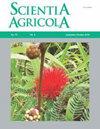热带环境下黑胡椒的产量响应因子和初始生长
IF 2.6
3区 农林科学
Q1 Agricultural and Biological Sciences
引用次数: 0
摘要
黑胡椒在巴西广泛生产,但很少有关于其水分需求和热带条件下水分亏缺(WD)影响的研究。采用自动管理灌溉系统,对布拉干地纳(Bragantina)品种灌水植株的生长、对WD的敏感性和第一年生产力进行了评价。采用不同流量(2.2 [T1]、3.3 [T2]、4.3 [T3]和5.3 L h - 1 [T4 -对照])的喷射器,在田间安装的塑料盆中栽培391 d。叶片、茎和芽的鲜重,叶片、茎、根和芽的干重以及植株的总干重进行了评估。生产力是通过评估一次收获的谷物和穗数来确定的。利用产量结果和整个生长季的实际蒸散速率与最大蒸散速率计算Ky系数。在1346 mm的降雨量下,灌溉系统被激活了165次,平均分配水量分别为19.0 (T1)、28.5 (T2)、37.1 (T3)和45.8 L(对照)。所有性状均受WD的负向影响,获得的Ky值(1.72 ~ 2.96)表明黑胡椒对WD的敏感性较高。总的来说,至少占作物需水量81%的处理所产生的穗状花序比欠优处理产生的穗状花序更大、数量更多。黑胡椒花期发病严重影响黑胡椒穗粒的大小、重量和品质。本文章由计算机程序翻译,如有差异,请以英文原文为准。
Yield response factor (Ky) and initial growth in black pepper in a tropical environment
: Black pepper is widely produced in Brazil, though there are few studies related to its water requirements and the effects of water deficit (WD) applied under tropical conditions. The growth, sensitivity to WD, and first-year productivity of irrigated plants from the Bragantina cultivar were evaluated, employing an irrigation system with automatic management. The plants were cultivated in plastic pots installed in the field for 391 days using emitters with different flow rates (2.2 [T1], 3.3 [T2], 4.3 [T3], and 5.3 L h –1 [T4 – control]). Fresh weight of the leaves, stems, and shoots, and dry weight of the leaves, stem, roots, and shoots as well as the total dry weight of the plant, were evaluated. Productivity was determined by evaluating the grains and spikes from a single harvest. Yield results and the actual versus maximum evapotranspiration rate for the entire growing season was used for calculating the Ky coefficient. Despite 1,346 mm of rainfall, the irrigation system was activated 165 times, distributing a mean volume of 19.0 (T1), 28.5 (T2), 37.1 (T3), and 45.8 L per plant (control). All traits were negatively affected by the WD, and the Ky values obtained (from 1.72 to 2.96) indicate the high sensitivity of black pepper to WD. In general, the spikes produced with at least 81 % of the crop water demand were larger and more numerous than those subjected to inferior treatments. WD occurring during the flowering stage severely hampers the size, weight, and quality of the spikes and grains of black pepper.
求助全文
通过发布文献求助,成功后即可免费获取论文全文。
去求助
来源期刊

Scientia Agricola
农林科学-农业综合
CiteScore
5.10
自引率
3.80%
发文量
78
审稿时长
18-36 weeks
期刊介绍:
Scientia Agricola is a journal of the University of São Paulo edited at the Luiz de Queiroz campus in Piracicaba, a city in São Paulo state, southeastern Brazil. Scientia Agricola publishes original articles which contribute to the advancement of the agricultural, environmental and biological sciences.
 求助内容:
求助内容: 应助结果提醒方式:
应助结果提醒方式:


